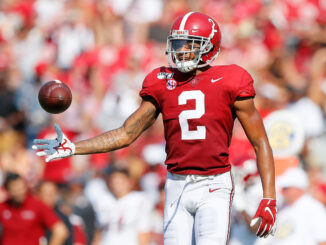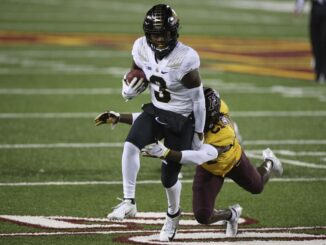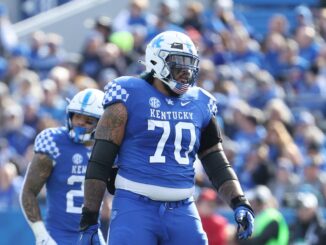The 2021 safety class is one of the few positional groups to have a standout No. 1 prospect. Trevon Moehrig is the only player I have a first round grade on in this year’s class, but there is still plenty of talent behind him. There are a number of players who could start from day one in the NFL and I have six players ranked inside the first two rounds. Here are my top ten safeties in the 2021 NFL Draft.
2021 Position Rankings
QB | RB | WR | TE | OT | IOL | IDL | EDGE | LB | CB
1. Trevon Moehrig – TCU

Pros: Moehrig is a fantastic athlete, with the range you want in a safety. He is comfortable in single-high or split-safety looks and also offers slot cornerback versatility. Moehrig possesses fluid hips and great change of direction ability and has no issue when asked to turn and run with a receiver. TCU’s quarters-heavy defense often saw him play in man coverage against slot receivers and tight ends and he held his own. Moehrig is one of the best ball hawks in this year’s class and he logged a forced incompletion rate of 29.1 per cent throughout his career. This is the third highest rate in this year’s safety class. He was consistently productive throughout his three years as a starter and allowed a passer rating of just 54.7 in his college career.
Cons: Whilst Moehrig is excellent in coverage, the same can’t be said for his run defense. He is often over-aggressive when coming downhill and this leads to him taking poor pursuit angles and overrunning the play. This also makes tackling more of a challenge and he has had issues wrapping up consistently. Moehrig had a 14.3 per cent miss rate throughout his time at TCU and needs to improve on his technique. At the moment he tends to launch himself at the ball carrier, rather than using proper form.
Projection: 1st round
2. Richie Grant – UCF

Pros: Grant was a three-year starter at UCF and enters the draft with a tonne of quality football to his name. His form in 2020 was incredible and he allowed just 171 yards on his 32 targets, giving up a passer rating of 32.2. His instincts are exceptional and should translate really well to the next level. He processes the game quickly and this showed up with his ball production. Grant finished his time in college with 29 forced incompletions on 125 career targets. He is a versatile player, who is comfortable as a deep safety, in the box, or moving out to the slot. He also looked like one of the best tacklers in the class last season, with just six misses on 78 attempts.
Cons: At 5’11” and 197 lbs, Grant lacks ideal size. Although he has a physical brand of football, some may be wary about using him in the box at that weight. Despite having exceptional length, he can have issues working through traffic against the run and gets stuck on blocks too easily. His long speed isn’t great either, running a 4.54 at his pro day. UCF rarely tasked him with playing in single coverage and is difficult to say how he would handle such responsibilities at the next level. Grant is an older prospect and will turn 24 as a rookie.
Projection: 2nd round
3. Jamar Johnson – Indiana

Pros: Johnson’s sample size was limited in college but he rivals Moehrig as the best coverage safety in the 2021 class. He allowed a 52.3 per cent completion rate on his 44 career targets and gave up a passer rating of just 32.2 across his career. For context, the passer rating of a throwaway is 39.6. Despite his relative inexperience, Johnson showcases elite instincts and the ball skills you want in a safety. His 29.5 per cent forced incompletion rate ranks second in this year’s draft class. He is a good athlete, with fluid hips and smooth movement skills in space. Johnson also offers plenty of versatility. He played the ‘husky’ role at Indiana, which is a mix of safety, cornerback, and linebacker. He showed himself to be an excellent blitzer too, with 11 pressures and four sacks on 33 career pass rushing snaps.
Cons: The major concern with Johnson are his problems as a tackler. He had a 26.5 per cent miss rate throughout his career, which ranks as the worst in the entire 2021 class. Whilst he gets in the right place to make the tackles, he struggles to wrap up. A lot of this is down to poor technique and bad pursuit angles that make his job more difficult. His run defense is average and he doesn’t seem keen on coming downhill to make plays on the ball carrier. Johnson’s long speed isn’t ideal and he would likely fit best in a two-high scheme.
Projection: 2nd round
4. Andre Cisco – Syracuse

Pros: Few safeties can rival Cisco from an athleticism standpoint. He has the fluid hips and change of direction ability to be an excellent single-high safety in the NFL and pairs this with serious speed. He has reportedly run a 4.33 40-yard dash and this shows on tape with his incredible range. Cisco also offers ideal size for a safety at 6’0″ and 216 lbs with a 77.25″ wingspan. His ball skills are amongst the best we have seen in a safety prospect in recent years. Cisco logged an incredible 26 forced incompletions in just 24 career games. His 34.6 per cent forced incompletion rate is easily the best in this year’s class.
Cons: Cisco’s splash plays are exceptional but he is incredibly inconsistent in coverage. He leads the class in forced incompletion rate but was also responsible for allowing eight touchdowns on his 75 career targets. He has a tendency to freelance in coverage and this just won’t cut it at the next level. Cisco needs to be more disciplined and has a bad habit of biting on misdirection and double moves. This recklessness carries over to the running game and he has issues with his pursuit angles. This often resulted in issues as a tackler too, with a 16.3 per cent career miss rate. Cisco also tore his ACL midway through the 2020 season.
Projection: 2nd round
5. Ar’Darius Washington – TCU

Pros: Washington has exceptional instincts in coverage and was consistently productive during his time at TCU. He logged an impressive 12 forced incompletions on his 37 career targets. He also allowed just seven first downs in his career and gave up two games of 20+ yards. His 2019 form was exceptional and Washington gave up just five catches for 65 yards through 12 games. Despite lacking ideal size, Washington plays the game with genuine toughness and is a hard-hitting tackler. He does a decent job of wrapping up in space and shows the willingness you want to see against the run.
Cons: At just 5’8″ and 178 lbs, Washington is one of the smallest defensive prospects in this year’s class. Rightly or wrongly, teams will have concerns about this and whether or not he can hold up effectively in the NFL. Unsurprisingly he can struggle when left one-on-one with bigger receivers and his lack of length makes block deconstruction a challenge. Washington also lacks elite speed to make up for his stature, running a 4.61 40-yard dash at his pro day. He plays faster on tape, but there will be questions about whether or not he can play single-high in the NFL. His best fit may be as a slot cornerback.
Projection: 2nd round
6. Jevon Holland – Oregon

Pros: Holland’s instincts rank amongst the best in this year’s class. He processes all facets of the game quickly, whether playing coverage or stopping the run. He was a consistent presence in the Ducks’ secondary for two years and allowed a passer rating of just 61.1 on his 104 career targets. Holland is also one of the most reliable tacklers at the position and showcases great form, logging just nine misses on 80 attempts in 2019. He has proven himself to be willing and able as a run defender and does a nice job of getting off blocks and making plays on the ball carrier.
Cons: Holland tested well at his pro day, but he isn’t the most athletic player on tape. He is a little stiff hipped and his change of direction ability isn’t ideal. Whilst his short area quickness is sufficient, there will be questions about whether he has the long speed to play as a single-high safety at the next level. Holland made a name for himself with his slot/safety versatility but he can have issues in single coverage against more shifty receivers. As such he is unlikely to stay in the slot at the next level.
Projection: 2nd round
7. Divine Deablo – Virginia Tech

Pros: One of Deablo’s biggest strengths is his size. At 6’3″ and 226 lbs he is one of the biggest safeties in this year’s class. This comes with the physicality you would expect and Deablo is a really hard-hitting tackler. He executed a versatile role at Virginia Tech, playing both safety spots, as well as playing around a third of his snaps in the slot. He is one of the better tacklers in this year’s class and does a nice job wrapping up in space. His 78.9″ wingspan helps him in the running game too and he is excellent at working off blocks. He showed real improvements in coverage in 2020 and allowed a passer rating of just 56.8.
Cons: Deablo lacks ideal movement skills for an NFL safety. He has stiff hips and his change of direction ability is sub-par. He isn’t slow, but he lacks the range you would want in a single-high safety and this makes him a tough sell at the next level. Reports suggest that many teams view him as a linebacker and given his size and strength he could fit there. That said, he has never played the position before in either college or high school and it would require substantial adjustment. Deablo is also one of the older safety prospects in this year’s class, turning 23 as a rookie.
Projection: 3rd round
8. Tyree Gillespie – Missouri

Pros: Gillespie was a three-year starter for Missouri and held his own against top competition. He has good short area quickness and the change of direction ability you want in a safety. Whilst he didn’t have a single interception in his career he was excellent at the catch point. He has good length and physicality to compete with receivers and logged 10 forced incompletions on his 47 career targets. Gillespie is a big safety who packs a real punch as a tackler. He is a solid run defender and takes consistently excellent pursuit angles.
Cons: Gillespie played mainly as a free safety in college, but he will likely be limited to a box role in the NFL. He lacks the range you want at the position and doesn’t have the closing burst to be a consistent force in coverage. His instincts are also fairly average and he doesn’t have the anticipatory playstyle that teams will look for. Whilst he is a hard-hitting tackler, he isn’t always that consistent. He has a bad habit of tackling tall and missed 13.9 per cent of his attempts throughout his career.
Projection: 4th round
9. Christian Uphoff – Illinois State

Pros: Uphoff is an excellent athlete, with the burst and long speed you want from a defensive back. His movement skills are legitimately impressive and he has the fluid hips and quick feet to play comfortably in single coverage. Uphoff is a classic do-it-all safety, with the ability to play in single-high and split safety looks, as well as moving into the box. Illinois State often used him in the slot too, and he has the turn-and-run ability to succeed there in the NFL. He is a playmaker in coverage, with a 28.8 per cent forced incompletion rate across his career. Uphoff was one of the biggest winners at the Senior Bowl and also offers special teams value as a returner.
Cons: The concerns with Uphoff are fairly obvious. He has just one season as a starter in college. He only has experience of FCS football, and whilst he was impressive at the Senior Bowl, we haven’t seen him consistently tested by top collegiate competition. The lower level of competition often allowed him to rely on his superior athletic traits, but this won’t cut it in the NFL. His instincts are still developing and he isn’t the fastest processor. This could be even more apparent at the next level. His tackling is hit and miss too, with a 13.8 per cent miss rate.
Projection: 4th round
10. Hamsah Nasirildeen – Florida State

Pros: Nasirildeen has rare size for a safety. At 6’3″ and 215 lbs he is one of the biggest in the class and he pairs this with incredible length. He measured in with an 81.8″ wingspan, and his 34.5″ arms are the longest ever in a safety prospect. On the field he is a hard hitter and was responsible for three forced fumbles in 2019. His length helps him to be a really secure tackler and his 9.4 per cent miss rate is the best of any player on this list. He was an incredibly versatile player on the Seminoles’ defense, playing a mixture of safety, linebacker, and slot corner. He even had reps off the edge and as a boundary corner.
Cons: Nasirildeen is not a particularly dynamic or explosive athlete. He logged a 32″ vertical jump at his pro day, which ranked in just the 9th percentile at the position. He isn’t particularly fluid either and he has pretty stiff hips for a safety. Nasirildeen had four career interceptions but I would be wary of calling him a playmaker in coverage and he could struggle to transition to the speed of the NFL game. He is something of a tweener at this point and may find himself having to switch to linebacker in the NFL. He tore his ACL in 2019 and played just two games last season.
Projection: 4th round


